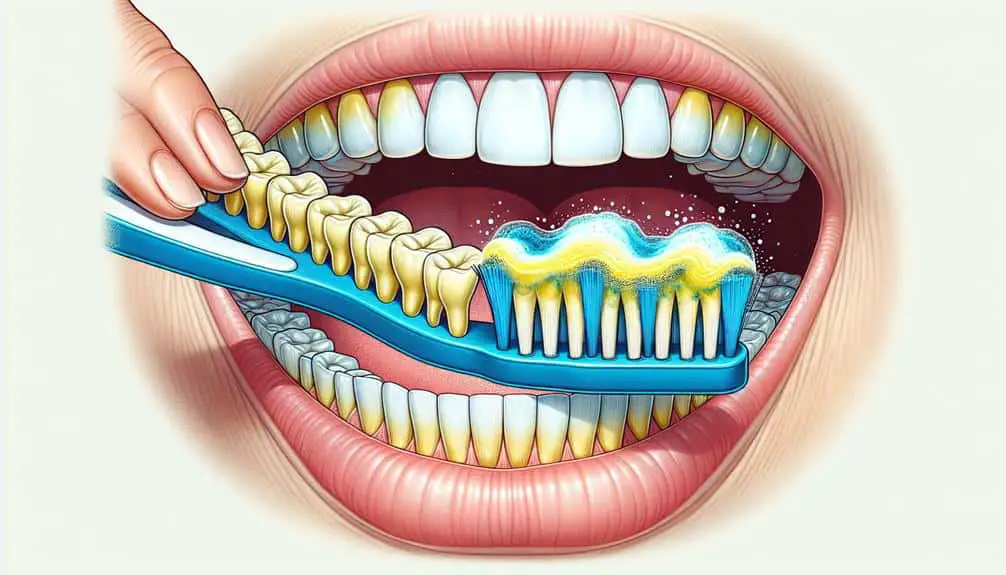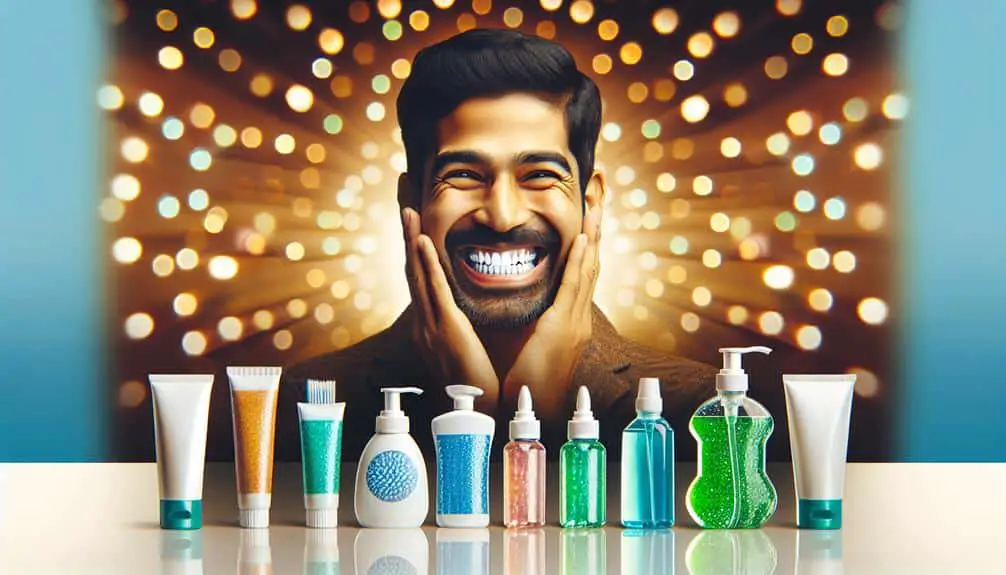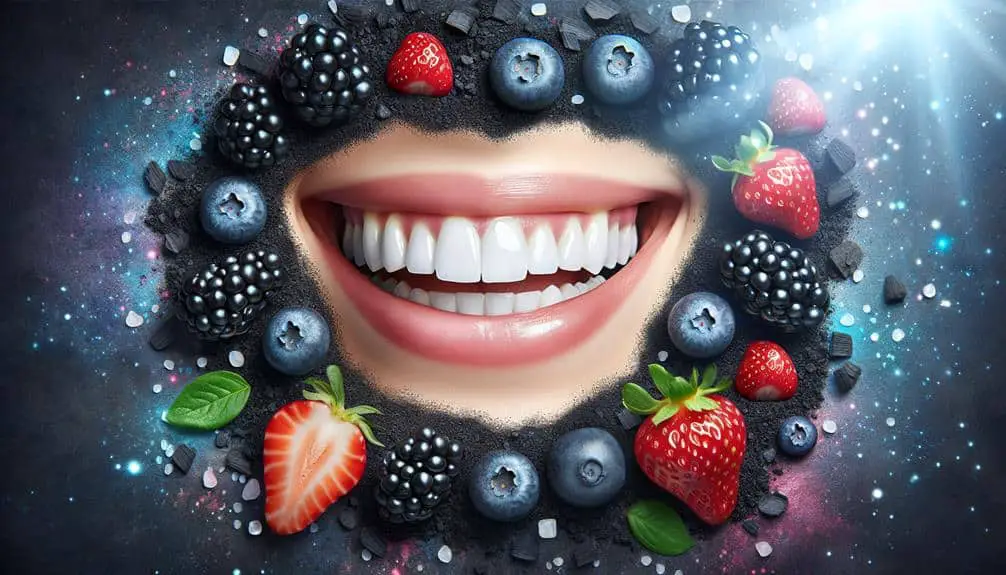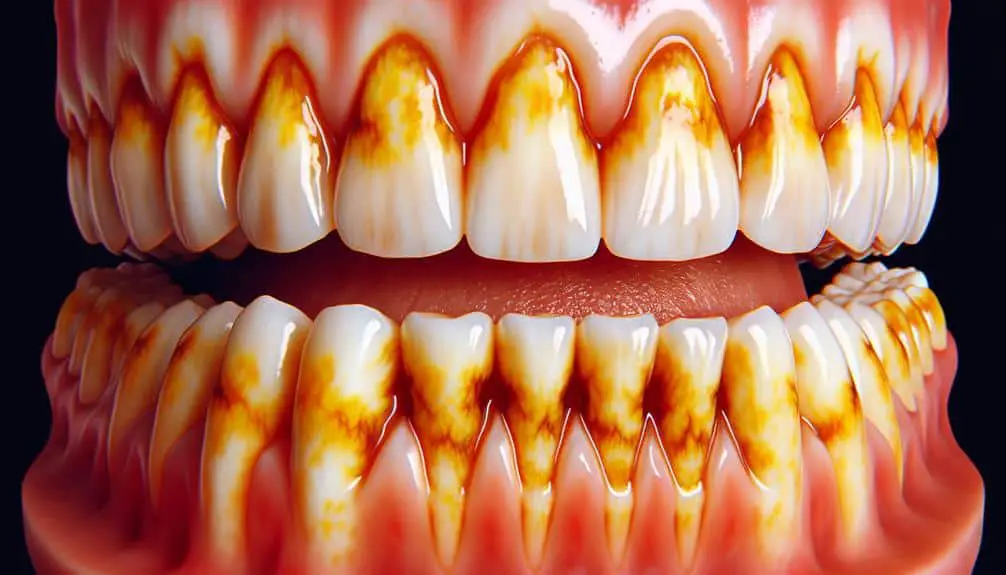To remove fluoride stains, start with oil pulling using coconut or sesame oil. Try a baking soda paste to gently scrub away surface stains. Consider rubbing lemon or orange peel on teeth for natural acidity. Prevent future stains by limiting fluoride-rich products and maintaining oral hygiene. Professional whitening treatments offer quick results like dental bleaching. Prevent staining by limiting dark drinks such as coffee and red wine. For natural whiteness, use herbal remedies like sage and salt toothpaste. Dietary changes with apples, carrots, and celery can act as natural cleansers. Incorporate these remedies to maintain teeth whiteness effectively. More strategies await for perfecting your smile.
Key Points
- Oil pulling with coconut or sesame oil reduces stains over time.
- Use baking soda paste to gently scrub away surface stains.
- Rub teeth with lemon or orange peel to lessen stain appearance.
- Avoid excessive fluoride products to prevent further staining.
- Practice good oral hygiene to reduce fluoride stain buildup.
Understanding Fluoride Stains
Have you ever wondered how fluoride stains develop on teeth and what causes them to occur? Fluoride stains, also known as dental fluorosis, develop when teeth are overexposed to fluoride during their formative years. This typically happens from ingesting too much fluoride through sources like water, toothpaste, or supplements. The excess fluoride disrupts the enamel formation process, leading to the development of white or brown stains on the teeth.
The main cause of fluoride stains is the excessive intake of fluoride during the tooth development stage. This can happen from swallowing fluoride toothpaste, living in areas with high fluoride levels in the water, or taking fluoride supplements unnecessarily. The severity of the stains can vary depending on the level of overexposure to fluoride.
Treatment options for fluoride stains include professional teeth whitening procedures, dental bonding, veneers, or crowns. These treatments aim to improve the appearance of the stained teeth and restore a bright, white smile. It's essential to consult with a dentist to determine the best treatment option based on the severity of the stains.
DIY Remedies for Stain Removal
To effectively tackle fluoride stains at home, consider trying out various do-it-yourself remedies that can help in the removal process. Home remedies can be a cost-effective and convenient way to address mild to moderate fluoride stains on your teeth. One popular method is oil pulling, where swishing coconut or sesame oil in your mouth for about 15-20 minutes may help reduce stains over time.
Baking soda mixed with water to form a paste can act as a gentle abrasive to scrub away surface stains caused by fluoride. Additionally, rubbing a lemon peel or orange peel on your teeth can help reduce the appearance of stains due to their natural acidity.
Stain prevention is key to maintaining a bright smile. Avoiding excessive consumption of fluoride-rich products like certain toothpaste and mouth rinses can help prevent future stains. In addition, practicing good oral hygiene by brushing and flossing regularly can aid in reducing the buildup of stains caused by fluoride.
Professional Whitening Treatments
Professional dental whitening treatments offer effective solutions for removing stubborn stains and enhancing the brightness of your smile. In-office procedures conducted by trained professionals are a popular choice for those seeking quick and noticeable results. Dental bleaching, a common technique used in professional whitening treatments, involves the application of a bleaching agent to the teeth to lighten the color of the enamel.
During an in-office procedure, a protective gel is applied to your gums to safeguard them from the bleaching agent. The bleaching agent is then carefully applied to your teeth and activated with a special light or laser to accelerate the whitening process. This method allows for a significant reduction in stains caused by fluoride and other factors, resulting in a brighter smile in just one visit.
Professional whitening treatments are tailored to your specific needs and can address even the most stubborn stains effectively. The expertise of a dental professional ensures that the procedure is safe and minimizes the risk of sensitivity, providing you with a whiter, more radiant smile.
Preventing Future Stains
To prevent future stains, regularly implement proper oral hygiene practices, including daily brushing and flossing. Brush your teeth at least twice a day with fluoride toothpaste to remove plaque and prevent the buildup of stains. Remember to floss daily to clean between teeth and along the gumline, where stains can easily develop. Additionally, consider using a mouthwash that's specifically designed to help prevent stains and maintain oral health.
In addition to oral hygiene, be mindful of your dietary choices to prevent staining. Limit your intake of dark-colored beverages like coffee, tea, and red wine, as these can contribute to staining on the teeth. When consuming these beverages, consider using a straw to minimize contact with your teeth. Avoid or reduce consumption of sugary and acidic foods and drinks, as they can weaken enamel and make teeth more susceptible to staining.
Natural Ways to Maintain Whiteness
Maintaining the whiteness of your teeth naturally involves incorporating specific habits and remedies into your daily oral care routine. Herbal remedies can be beneficial in maintaining the brightness of your smile. For example, using a mixture of sage and salt as a natural toothpaste can help remove surface stains and prevent discoloration.
Additionally, incorporating dietary changes can play a significant role in keeping your teeth white. Foods high in fiber such as apples, carrots, and celery can act as natural teeth cleaners by increasing saliva production and scrubbing away plaque. Moreover, consuming strawberries, which contain malic acid, can aid in whitening your teeth by breaking down stains.
Remember to limit the intake of staining beverages like coffee and red wine to prevent discoloration. By integrating these herbal remedies and dietary adjustments into your routine, you can effectively maintain the whiteness of your teeth in a natural and holistic manner.
Frequently Asked Questions
Are Fluoride Stains Permanent or Can They Be Completely Removed With Treatment?
Fluoride stains may not be permanent. Various treatments, ranging from professional cleanings to whitening products, can help remove them. Consistent oral care and avoiding excessive fluoride exposure contribute to prevention and long-term effects.
Can Children and Teenagers Also Get Fluoride Stains on Their Teeth, and if So, Are the Treatment Options Different for Them?
Children and teenagers can develop fluoride stains on their teeth. Pediatric concerns are addressed differently than in adults. Treatment options for adolescents may involve professional cleaning, whitening procedures, or dental products specifically designed for younger individuals.
Are There Any Specific Foods or Drinks That Should Be Avoided to Prevent Fluoride Stains From Recurring?
To prevent recurring fluoride stains, you should consider dietary restrictions. Avoid foods high in fluoride content like tea, seafood, and processed beverages. Opt for low-fluoride alternatives and maintain good oral hygiene practices to keep stains at bay.
How Long Does It Typically Take to See Results From Professional Whitening Treatments for Fluoride Stains?
For professional whitening treatments to address fluoride stains, results can typically be seen after a few sessions, varying based on the severity of staining. Professional options tend to yield quicker and more successful outcomes compared to at-home treatments.
Are There Any Potential Side Effects or Risks Associated With Using Natural Remedies to Maintain Whiteness and Prevent Future Stains on Teeth?
When using natural remedies for teeth whitening, consider potential risks and side effects. Some options may cause sensitivity or irritation. To prevent future stains, maintain good oral hygiene practices and consult with your dentist for personalized recommendations.



